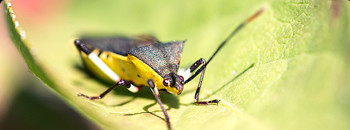Congratulations on embarking on your homeownership adventure! As you enter this next phase of life, there are a lot of factors to consider – from school districts to bedrooms to nearby parks. That’s why we’ve pulled together a few steps that make it easy for you to make sure you’re not purchasing a home with any extra, unwanted roommates. Pests can hide in nooks and crannies throughout homes, so it’s important to always check for signs of unwelcome bugs, insects and rodents.
Here are the most common pests that invade homes and how to spot them:
- Moths: Seemingly harmless, these insects will chew through your clothing, bedding or even furniture. As you tour new homes, check for small holes in fabric such as curtains.
- Cockroaches: Cockroaches are both gross and dangerous, as they can cause disease in humans. Keep an eye out for dead bugs or brown spots around cabinets. Cockroaches can be especially problematic, as an American cockroach can produce one capsule containing 16 eggs each week.
- Termites: On average, termites cost Americans $5 billion in repairs each year, which isn’t covered by insurance. Always be on the lookout for wood dust, sagging floors or visible holes.
- Bed bugs: As if bed bugs sucking human blood isn’t bad enough, professional removal can cost as much as $1,500. Check for rust colored stains on bedding or furniture, as well as cream colored eggs in crevices, as these are signs of an infestation. These bugs can travel at a rate of three to four feet per minute and can be left behind by previous homeowners, making them hard to catch and even harder to get rid of.
- Rodents: Rodents, such as mice, rats and squirrels, carry several diseases and can chew through insulation, wood and wires. In fact, 25 percent of home fires are thought to be caused by rodents. Signs of a rodent infestation include oily or musty smells, rodent traps placed by the homeowner, open siding or holes in baseboards and droppings. Prevention is key, as mice can enter a home through a home as small as ¼-inch wide.
Be sure to check out the house during different times of day (that family of squirrels may have left in the morning but come home for supper at night). Our recommendation is to have a home inspected by a professional before you sign the dotted line!
And, if you’re selling your home, remember to keep windows and doors closed as much as possible during open houses. May is the best month to sell your home, but it also means temperatures are warm enough for pests to be out and about. Show potential buyers your dedication to bug-free spaces by having your home inspected regularly by professionals. It’s important to note buyers can negotiate a sizable discount if a property is infested with pests. These houses also tend to sit on the market for long periods of time, so taking the proper steps to prevent infestations and monitor for potential problems is key.

